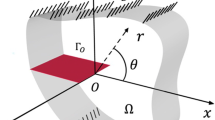Abstract
The present paper is concerned with the formulation of the singularity subtraction technique in the dual boundary element analysis of the mixed-mode deformation of general homogeneous cracked plates.
The equations of the dual boundary element method are the displacement and the traction boundary integral equations. When the displacement equation is applied on one of the crack surfaces and the traction equation is applied on the other, general mixed-mode crack problems can be solved in a single region boundary element formulation, with both crack surfaces discretized with discontinuous quadratic boundary elements.
The singularity subtraction technique is a regularization procedure that uses a singular particular solution of the crack problem to introduce the stress intensity factors as additional problem unknowns. The single-region boundary element analysis of a general crack problem restricts the availability of singular particular solutions, valid in the global domain of the problem. A modelling strategy, that considers an automatic partition of the problem domain in near-tip and far-tip field regions, is proposed to overcome this difficulty. After the application of the singularity subtraction technique in the near-tip field regions, regularized locally with the singular term of the Williams' eigenexpansion, continuity is restored with equilibrium and compatibility conditions imposed along the interface boundaries. The accuracy and efficiency of the singularity subtraction technique make this formulation ideal for the study of crack growth problems under mixed-mode conditions.
Similar content being viewed by others
References
G.E. Blandford, A.R. Ingraffea and J.A. Liggett, International Journal of Numerical Methods in Engineering 17 (1981) 387–404.
A. Portela, M.H. Aliabadi and D.P. Rooke, International Journal of Numerical Methods in Engineering, in press.
N.I. Muskhelishvili, Some Basic Problems of Mathematical Theory of Elasticity, first published in Russian (1933). English translation P. Noordhoff, The Netherlands (1953).
M.H. Aliabadi, D.P. Rooke and D.J. Cartwright, Journal of Strain Analysis 22 (4) (1987) 1–5.
A. Portela, M.H. Aliabadi and D.P. Rooke, in Proceedings of the Fourth International Conference on Boundary Element Technology, Windsor, Canada, C.A. Brebbia (ed.) Computational Mechanics Publications, Southampton =UK (1989).
M.H. Aliabadi, in Proceedings 4th International Conference on Numerical Methods in Fracture Mechanics, San Antonio, Texas, Pineridge Press, Swansea (1987) 27–38.
A. Portela, M.H. Aliabadi and D.P. Rooke, International Journal of Numerical Methods in Engineering 32 (1991) 445–470.
M.L. Williams, Journal of Applied Mechanics (1952) 526–528.
H.M. Westergaard, Journal of Applied Mechanics (1939) A49–53.
M.H. Aliabadi and D.P. Rooke, Numerical Fracture Mechanics, Computational Mechanical Publications, Southampton (1991).
M.B. Civelek and F. Erdogan, International Journal of Fracture 19 (1982) 139–159.
Y. Murakami, Stress Intensity Factors Handbook, Pergamon Press, London (1987).
Author information
Authors and Affiliations
Rights and permissions
About this article
Cite this article
Portela, A., Aliabadi, M.H. & Rooke, D.P. Dual boundary element analysis of cracked plates: singularity subtraction technique. Int J Fract 55, 17–28 (1992). https://doi.org/10.1007/BF00018030
Received:
Accepted:
Issue Date:
DOI: https://doi.org/10.1007/BF00018030




